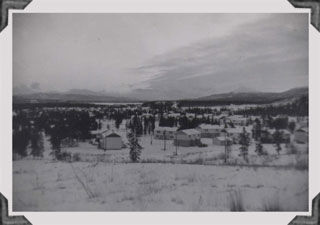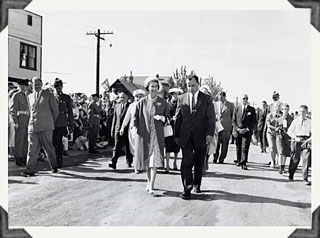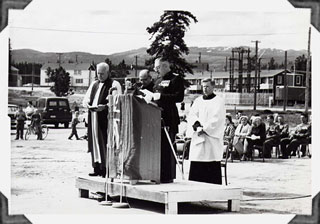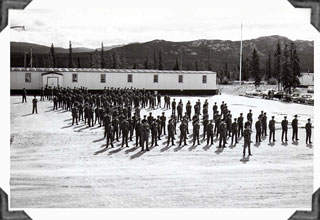Page
12: Whitehorse
Radio Station
The first Whitehorse radio station was established in 1935 to serve
the needs of an experimental air service between Seattle, Washington,
and Alaska. It became part of the NWT and Y Radio System in 1938.
During
World War II the Americans built the Alaska Highway to ensure a secure
supply route to Alaska, a safer and cheaper alternative to sea and
air transport. In 1946, after the war ended, Canada took over the
Canadian section of the Highway and established the Northwest Highway
System, which supervised and maintained this part of the Highway from
its headquarters in Whitehorse.
Owing
to the shortage of signallers resulting from the demands of the Korean
War, the Whitehorse radio station was transferred from the NWT and
Y Radio System to the Canadian Army Signal System. The Whitehorse
Signals officer acted under direct command of the Northwest Highway
System, but still reported to the Northwest Territories and Yukon
Radio System Headquarters in Edmonton on revenue from commercial traffic
and Department of Transport weather reports.
Camp
Takhini
Camp
Takhini, like all army camps, displayed the usual selection of neat
and tidy, nicely painted nondescript buildings that the military considers
suitable for barracks, messes, and various types of storage. It also
boasted an impressive headquarters building in which were located
various administrative offices, including the Signals office. Married
quarters were provided for the soldiers' families. Scattered through
the camp site were trees, standing singly or in small groups between
the buildings, that helped give the rather bleak camp a more pleasing
aspect.

Camp Takhini, 1960
We
were formally introduced by the appropriate officer to our PMQ, a
semi-detached house on Seine Square, facing inwards to the camp. Located
at the edge of Camp Takhini, its back door looked out beyond a laneway
and a fence to the Alaska Highway and its occasional traffic.
These
married quarters were furnished, the furniture solid and suitable
for the young families who were its customary occupants. As in Aklavik,
the provision of furnished quarters saved the occupants both time
and trouble. No time was spent in lodgings waiting for household furniture
and effects to arrive from the considerable distance that we had come.
Our few extra needs arrived fairly soon by truck. We found that the
television set, which we had been advised to take with us, would have
been better left behind in Winnipeg. Television was not available
in Camp Takhini in 1959.
Although the army families were housed in Camp Takhini, the children's
school, a large modern building, was in Whitehorse proper. Army buses
provided transportation from the camp; their crews composed of a driver
and another soldier whose business it was to keep order. According
to our children, his commanding cry of "Sit down and shut up!"
- in a parade-ground voice - usually did the trick!

H.M. Queen Elizabeth II walks along Front Street, Whitehorse, with
Gordon Cameron, Mayor of Whitehorse (July18, 1959)
The
Queen's Visit to Whitehorse
We had been in Whitehorse only a couple of weeks when, much to our
surprise, the Queen and Prince Philip arrived there on July 18th.
This was the first time I had seen the Queen since VJ Day, when a
girlfriend and I celebrated by joining the crowd at Buckingham Palace
to cheer the Royal Family as they waved from the balcony. She was
then Princess Elizabeth, not yet married, and wearing the uniform
of the ATS (Auxiliary Territorial Service), in which she had served
as a driver. It felt quite extraordinary to see her again in such
a remote place, so far from England, and now a wife and a mother.

Gordon
Cameron, Mayor of Whitehorse, escorts the Queen along First Avenue
(Front Street). Behind the Queen, Commissioner and Mrs. Collins and
Bonnie Cameron, the Mayor's wife.
The
whole town was excited about the visit. Everyone rushed first to the
airport to cheer the royal couple's arrival by plane, then to the
railway station, from which a special trip on the White Pass and Yukon
Railway had been arranged. Crowds applauded as the royal party walked
along Front Street to the station, boarded the train, and waved to
us as it departed. After their train trip they returned to Whitehorse,
where the Queen, who was feeling unwell, rested until the next day.
She returned to Edmonton on the 19th while Prince Philip toured the
other parts of the North that they had originally been scheduled to
visit together.
The
Brigadier General

GOC's inspection, Camp Takhini, Whitehorse, 1961: Bishop Greenwood,
Brigadier Jones, Padre Alfred. (GOC: General Officer Commanding.)
Our
commanding officer, Brigadier General Robert (Bob) Jones, was a credit
to the Canadian Army in general and to the Royal Canadian Engineers
in particular. He had done a splendid job in Europe in the Second
World War, where, as a Lieutenant-Colonel in the Royal Canadian Engineers,
he had pioneered the use of the Bailey bridge for river crossings.
At two demonstrations for General Eisenhower, he and his men constructed
a forty-foot Bailey bridge across a river in the astonishing time
of fourteen and a half minutes - both in daylight and in the dark
of night. General Montgomery gave due credit to the speed and efficiency
of this mobile bridging method for its remarkable contribution to
the rapid advance of his troops.
On
his return to Canada after the war, Brigadier Jones was asked to take
over the job of rebuilding the Alaska Highway, which was then, he
discovered, little more than "a bulldozed trail through wilderness
and mountains. Thirteen camps dotted the highway as well as numerous
small airfields, all of which had to be supplied and maintained."
(Quotations are from Bob Jones's obituary in the National Post, April
14, 2000.)
He
stated, "I found that we were to take over a road that twisted
and wandered through mountains and muskeg down to the farmlands of
the Peace River area. There were an additional 200 miles of access
roads to airfields and several emergency landing strips. There were
a hundred temporary bridges in need of replacement and hundreds of
culverts of timber made of native timber. Most of the road was poorly
drained and many miles of dangerous curves would have to be rebuilt
in order to make it safe for civilian travel.
"The
winter of 1946-47, when Bob Jones took over the project, was extreme.
He recalled working in sustained temperatures of -70ºF, with
dips to -83ºF, when even gasoline turned to slush."

Whitehorse: GOC's Inspection, Camp Takhini, 1961. (The Signals unit
is at left front.)
The
Officers' Mess
The
Officers' Mess was, rather surprisingly, not in Camp Takhini itself,
but downtown in Whitehorse, at the eastern end of Sixth Avenue. It
was not a particularly memorable building but it served adequately
as a home for the single officers in particular, and the regular meetings,
functions, and entertainments of the officers in general.
During
the short nights of the northern summer it seemed that, no matter
what time the clock said, it was daylight when we arrived at the mess
for a party - and daylight when we left to go home. This convenience
helped make the whole business of driving to and from a mess function
more relaxed and flexible than it sometimes was further south. By
the time the shorter days and longer nights of winter arrived, the
route to the mess had become a familiar one
The
Brigadier was, naturally, anxious to maintain cordial relations between
the military and the civilian populations, and encouraged the men
under his command to mix socially with the townspeople. Consequently,
the more respectable citizens of Whitehorse were frequent guests at
mess functions, and both camp and town found that this mixture made
for very good parties!
The
local paper, the Whitehorse Star, published an article February 9,
1961, under the title "DND Bankrolls Local Economy." It
states that the "backbone of the economic life in Whitehorse
is the department of national defence payroll. Army and RCAF establishments
here provide a stabilizing element in the community.
"However,
their contribution is not only economic but also social. Perhaps more
than in many army camps or air force bases, the soldiers and airmen
take an active part in civic life. They join ball teams, fraternal
orders, the drama club, PTA's, service clubs, hockey teams and they
curl, ski, play darts, hold rummage sakes, hunt, fish, prospect .
. . well, there are few sharp lines of division between service people
and civilians. It's a friendly town and associations in public and
in private are amiable."
The
citizens of Whitehorse were indeed a compatible group and we appreciated
their friendly welcome. It was always interesting to hear the many
stories they could tell about life in the Yukon, its current events,
and its past history.
[Next
Page]
Pages: [1]
[2] [3]
[4] [5]
[6] [7]
[8] [9]
[10] [11]
[12] [13] [14]
[15] [16]
Return to top of
page
Return to the Watts
Family page